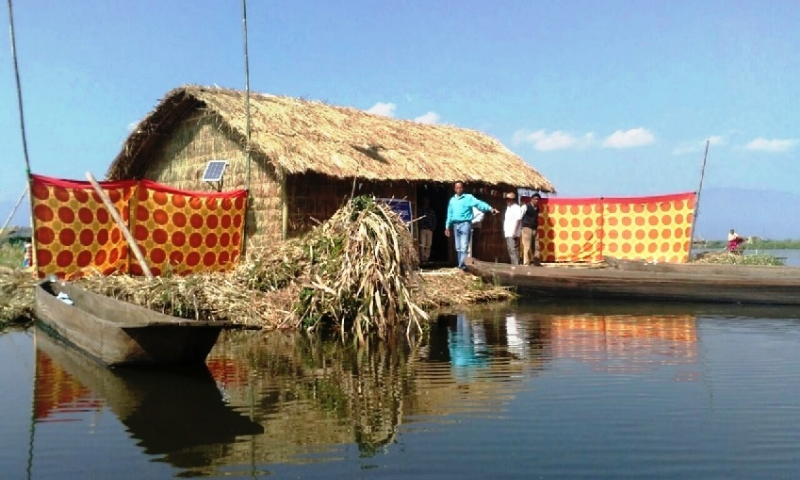Manipur Floating school on Loktak Lake faces uncertain future, needs urgent help to stay afloat: Report
Summary of the News Article
Eight years after Manipur’s first floating elementary school was launched on Loktak Lake (set up 2017 for children of fishing communities), the school is now fighting for survival. With only about 23 students enrolled and basic infrastructure lacking, community leaders have appealed urgently for government support to continue operations and gain official recognition amid ongoing challenges
Manipur’s Floating School on Loktak Lake: Treading Water with an Uncertain Future
1. Introduction: A School That Floats, But Faces an Uphill Battle
Imagine going to school and the ground beneath you drifting. That’s life at the Loktak Floating Elementary School, perched on phumdis—floating biomass islands—right on Loktak Lake in Manipur. Built in 2017 as a lifeline for kids in nomadic fishing communities, this one-room wonder is now struggling to stay afloat—literally and figuratively
2. The Origins: When Education Took to the Water
2.1 Why Build a School on Water?
- Geographic necessity: The lake’s phumdis house families who couldn’t access land-based schools. Boats were the only transport, and kids often dropped out.
- Community initiative: The All Loktak Lake Fishermen’s Union, with NGO PRDA and funding from ActionAid India, built the school to meet educational needs on-site
2.2 Crafted by Locals
This simple structure—24×15 feet—is built with bamboo, thatch, and wood, anchored sturdy on phumdibed. No formal architects, just local ingenuity ensuring it moves with the water, not against it
2.3 Class in Session
Initially hosting ~25 students and two community teachers, the school offered basic literacy and numeracy, even catering to illiterate adults. All powered by solar lights, with occasional internet access—proof that innovation doesn’t need grandeur
3. Why the School Mattered: A Beacon for Marginalized Kids
3.1 Tackling Dropout Rates
Evictions under the Loktak Lake (Protection) Act 2006 displaced many families. Without a school nearby, children were forced into labor or stayed home. The floating school reversed that trend—at least for a time
3.2 Bridging Distance
For families living on scattered phumdis, commuting to land every day meant long canoe rides. A floating classroom minimized travel time—and maximized attendance
4. Present Challenges: Why it’s Now Struggling to Survive
4.1 Shrinking Enrollment
As of mid‑2025, only 23 children remain—classes capped at Grade 2 and meeting twice a week. This drop reflects community displacement and shifting priorities during social unrest
4.2 Lack of Facilities
The school lacks even basic furniture. With no desks or proper flooring—just bamboo planks and carpets—it remains under-resourced despite years of operation
4.3 No Official Recognition
Despite repeated applications, state authorities haven’t formally recognized the school. Without accreditation, no teacher salaries, support grants, or expansion is possible. NGO PRDA continues to fill the gap with minimal resources
4.4 Community Distraction
Recent ethnic violence and displacement crises diverted attention and manpower, making education a secondary concern amid relief efforts
5. The Bigger Picture: Loktak Lake Under Threat
Loktak Lake isn’t just the school’s host—it’s sinking under ecological stress. Experts warn degradation from pollution, siltation, invasive signals, and altered hydrology due to the Ithai Barrage could destroy the lake within decades . If the lake dies, the floating school drowns too.
6. What Needs to Be Done: A Roadmap to Revival
6.1 Get Government Backing
Official recognition would unlock infrastructure funding, teacher stipends, and curriculum support—crucial for longevity.
6.2 Improve Infrastructure
Upgrade the floating school’s flooring, install desks, expand classroom space, extend hours, and possibly offer Grades 3–5 to retain learners.
6.3 Stabilize the Phumdi
Given that huts and the school shift during storms, anchoring remains fragile. Technical guidance to secure structures can reduce disruptions
6.4 Safeguard the Lake Ecosystem
Long-term survival of the floating school ties directly to Lake conservation: waste management, controlled tourist use, regulated fishing, and restoration plans to prevent phumdi loss
6.5 Mobilize Community & Partnerships
Bring in local universities, environmental groups, and education NGOs to support teacher training, adult literacy, and tech integration.
7. Why This School Still Holds Hope
7.1 A Symbol of Resilience
Despite hardship, the school remains active—a testament to community resolve and belief in learning as a lifeline.
7.2 Potential for Replication
The model’s simplicity and sustainability make it replicable for similar wetland communities across India and Southeast Asia.
7.3 Blending Tradition with Technology
Solar power, internet connectivity, and local design prove that even remote schooling can embrace modernity without losing local roots.
8. Conclusion: Will the School Sink or Swim?
The Loktak Floating Elementary School began as a beacon—small, community-built, and full of promise. Eight years later, that flame flickers. Without recognition, resources, or ecological stability, it risks fading. But with strategic support, conservation efforts, and renewed community focus, this unique school can survive—and continue lighting up Lake Loktak with the spark of literacy.
❓ Frequently Asked Questions (FAQs)
1. Where is the floating school located and who built it?
The school sits atop a phumdi near Champu Khangpok’s Langolsabi Leikai on Loktak Lake. It was established in 2016–17 by the All Loktak Lake Fishermen’s Union and the NGO PRDA, funded by ActionAid India
2. How many students attend and what grades does it serve?
As of mid‑2025, only ~23 students attend up to Grade 2, with classes held twice weekly. Enrollment has dropped steadily due to displacement and lack of expansion
3. What facilities does the school have?
A modest 24×15 ft room built on bamboo and wood, with no desks or formal furniture—students sit on carpeted floors. It has solar-powered lights but lacks formal recognition and grants
4. Why is the school not recognized by the government?
Despite applications, state authorities have not formally accredited the school—leaving it ineligible for public funding, teacher salaries, or curriculum integration
5. How is Loktak Lake’s condition affecting the school’s future?
The lake’s ecosystem is under threat from pollution, siltation, invasive species, and hydropower schemes. Experts warn it may degrade significantly within 50 years—jeopardizing any floating infrastructure atop it


